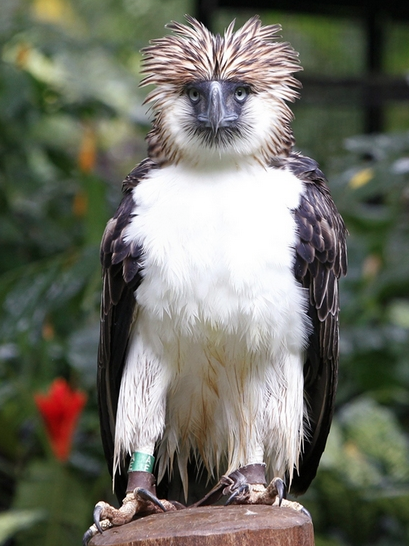THANK GOODNESS WE
DIDN’T LISTEN TO BEN!
Yes, it is true that Benjamin Franklin championed the Turkey
for our national symbol as opposed to the Bald Eagle. Ben actually called the
Bald Eagle lazy, and said the Turkey was a ‘bird of courage.’ I for one am very
grateful that Ben’s suggestion didn’t FLY!
J
We, here in the US, have worked hard to insure that our
symbol remains protected and free from threats. Our Bald Eagle is therefore
doing very well. However, there is another Eagle that is critically endangered.
The Philippine Eagle, also known as the Monkey-Eating Eagle (don’t worry, we’ll
get to the ‘why’ for that name in a bit) is the subject of this week’s post.
According to ARKive.org, this impressive bird is the world’
largest Eagle. However, from what I have read, in the bird world size is based
on particular criteria such as wingspan or weight. Even height is considered
when ranking eagles. The Philippine Eagle has a wingspan of up to seven feet,
can stand up to three feet high, and can weigh as much as seventeen pounds. The
below picture will give you an idea of just how big this bird is. Anyway you look
at it, this is a very large bird.
Photo credit: http://Carnivoraforum.com
The Philippine Eagle is endemic to the Philippines. It is
found on parts of the larger island of Luzon, Samar, Leyte and Mindanao.
Although it was widespread throughout the Philippine Islands at one point in
time, its numbers have dropped severely. It is now believed that there are less
than 250 mature individuals living.
Photo Credit: Wikipedia
For all my young friends who read my blog, the Philippine
Islands are located in the Pacific Ocean, north of Australia.
As we have already stated, the Philippine Eagle is critically
endangered, and there are active programs to help reintroduce this bird to the
jungles of the Philippines. A breeding program is ongoing in Davao, in the
Southern Philippines at the Eagle Foundation Conservation Center. Below is a
picture of one of the residents at this center. His name is Mindanao. The main
reason for the critically endangered status is habitat destruction.
In 1965, a Philippine ornithologist,
(a person who studies birds) named Dioscoro S. Rabor brought the issue of
diminishing numbers of this bird to Philippine and international attention. Shortly afterward, Charles Lindbergh, who was
a representative of the World Wildlife Fund, helped to persuade the government
of the Philippines to protect the eagle. The Eagle was finally declared the
national bird of the Philippines in 1995. It is now illegal to kill one of
these birds.
The Philippine Eagle is a raptor. Raptors include, eagles,
hawks, falcons, owls and vultures. They all hunt by sight and have powerful
talons for grasping their prey, and strong, sharp beaks for tearing meat. The
Philippine Eagle hunts by sight from the tops of trees. It will eat small mammals such as, lemurs,
rats, snakes, and yes, according to many of the sites I visited to create this
post, it will eat monkeys. It simply snatches them from trees.
Photograph by: Klaus
Nigge, National
Geographic March 2008
There truly are few words that can describe this splendid
bird. Considering the current status of this bird’s habitat, I think National
Geographic said it best; The Philippine Eagle is a King without a Kingdom.
I have found a video for you that shows the beauty of the Philippine
Eagle.
If you want to learn more about the Philippine Eagle, visit
the following sites:
I hope you enjoyed visiting Australian Fantasy Adventures,
and learning a bit about the Philippine Eagle. Please share my post with the
children in your family and your friends. Come back again next week for a look
at another unusual or endangered animals.
My sincere thanks to ARKive.org for some of the information
and pictures.
Enjoy
Jeanne E. Rogers, Author
The Sword of Demelza, an Award Winning Middle Grade Fantasy
Where Endangered Animal Heroes Roam the Pages!









